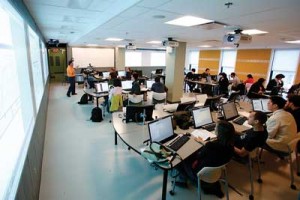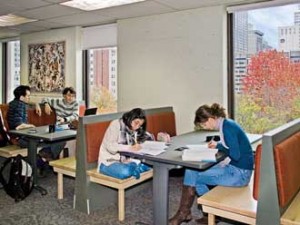
Renovated classrooms encourage active learning, collaboration
By Jim Hynes
The classroom of the future is already here.
BH-511, a high-tech “active learning” classroom in Burnside Hall, and the renovated Walter Hitschfeld Geographic Information Centre (See sidebar, Mapping the future) – the library the room is located within – were officially inaugurated on Oct. 27. Provost Anthony Masi, Teaching and Learning Services Director Cynthia Weston, Trenholme Director of Libraries Janine Schmidt, and Department of Geography Chair Tim Moore each spoke briefly before Geography Department Prof. Nigel Roulet gave an entertaining, 15-minute demonstration of the new room’s various features.
The renovation of BH-511, which took place this past summer, is part of a growing effort by the University to upgrade and modernize its classrooms and teaching labs to create environments that foster greater collaboration. The overhaul includes installing multimedia and wireless Internet connections, but also basic improvements such as proper ventilation, natural lighting, and seats that can be repositioned for work in groups.
The result is a 21st century learning environment. BH-511 features powerful computers for each of the 38 students it can accommodate, as well as a central console from which the lecturer can take control of a student’s computer and project it onto six large screens around the room. Another classroom, EDUC 627, was renovated at the same time as BH-511. With room for 72 students, it is already home to seven courses. It will be inaugurated Nov. 13.
Breaking down walls
The renovating of both rooms was recommended by the Teaching and Learning Spaces Working Group (TLSWG), a cross-unit committee that works to establish teaching and learning space standards based on sound pedagogical and technical principles; identify teaching and learning space needs; and investigate new teaching and learning technologies. The TLSWG sets priorities and recommends funding for the creation and upgrade of new and existing teaching and learning spaces at McGill.
“One of McGill’s goals is to create interactive teaching and learning spaces that provide opportunities for faculty to engage students in active and collaborative learning.” said Adam Finkelstein, an Educational Developer in Teaching and Learning Services and a member of TLSWG. “These spaces are different from your traditional lecture hall, where there is a hierarchical barrier between the instructor and the students. These new rooms are designed from the ground up to be collaborative and active spaces. It’s about getting students to actively participate in the learning. We’re trying to get away from the idea of having students sitting and listening all the time.”
Roulet, who has been teaching his Environmental Systems Modelling course (GEOG 501) in BH-511 since the beginning of the semester, is a big fan of the new room. It has allowed him to completely redesign his course. Rather than separating the material into weekly theoretical lectures and a practical lab, Roulet can now combine the two, leading the students through the material with a problem-based approach.
Nowhere to hide
“The room offers a number of different levels of interaction that improve students’ learning experience,” Roulet said. “Not only has instructor-student interaction improved, but the tables of six facilitate student interaction.” That said, “students have to participate to maximize their learning. They can’t hide as easily in this kind of room. They have to come prepared to be engaged,” he said.
And most do. Roulet’s students seem to like the new classroom …a lot.
“My favorite thing about BH-511 is how it pulls everyone into whatever is going on,” said Geoffrey Garver, a dual PhD Geography and LLM Thesis (Environment) student. “The room makes every workstation feel like it is in the front of the class. And the groupings of six workstations, and the way they are oriented, makes it easy to collaborate with other students. The ability of the professor to access student computers to illustrate problems or best practices is really great – on several occasions the whole class has been working together to try to de-bug a problem someone was having with their model.”
Amanda Connie Alfonso, an MSc Geography student in the same class as Garver, credits the new room with making the class less hierarchical and more interactive.
“Other students’ work is often shown on the multiple projector screens so that we help each other troubleshoot through problems and share our progress,” she said.
Alfonso’s favourite feature in BH-511 is the tablet at the main console.
“It allows the teacher to draw diagrams at any point during a lecture and it will show up on the multiple screens around the classroom, or he can just underline notes he is showing us to emphasize them…without wasting paper too.”
For more information on the Teaching and Learning Spaces Working Group, visit www.mcgill.ca/tls/tlswg/
Walter Hitschfeld Geographic Information Centre: Mapping the future
The renovated Walter Hitschfeld Geographic Information Centre (GIC) was inaugurated by Provost Anthony Masi on Oct. 27. Located on the 5th floor of Burnside Hall, the GIC is McGill’s primary resource for geospatial information and has operated as a partnership between the McGill University Library and the Department of Geography since 1997. It constitutes a vital teaching, learning and research space.
The GIC facilitates a unique mode of collaboration among the McGill Library, faculty, and students. A truly interdisciplinary facility, it enhances services to students in the Department of Geography, the McGill School of Environment, the Department of Earth and Planetary Sciences, the School of Urban Planning and the School of Architecture as well as students from the Faculties of Arts, Law, Engineering, Management and Medicine.
The newly renovated student-focused space blends a diverse range of studying and learning spaces for groups and individuals and various high technology and multimedia installations. With an expansion of the number of computers available, quality services can be provided through a team of specialists whose mission is to encourage effective use of geospatial data and GIS literacy at McGill.
“We are very excited about the renovation of the space, which puts the needs and preferences of our clients front and centre,” said Janine Schmidt, Trenholme Director of Libraries. “The GIC has been transformed into a more productive, better functioning learning space where students, teachers, and librarians focus on quality information access and learning experiences in a leading-edge environment.”
-Jessica Hunt

